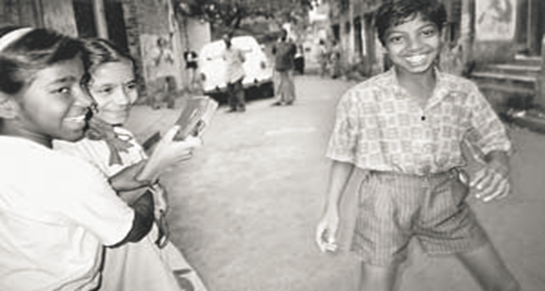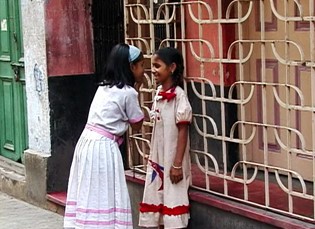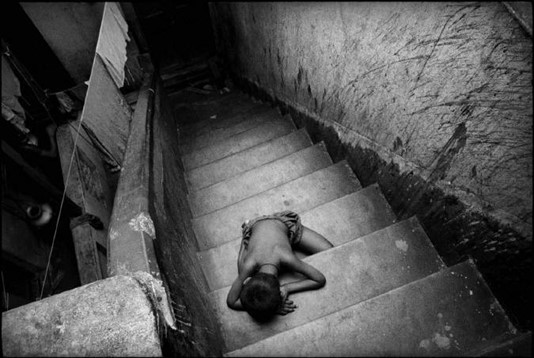Directed and produced by: Zana Briski and Ross Kauffman (2004)
Music: John McDowell
Length: 85 minutes
Link to the trailer: http://www.zanabriski.com/born-into-brothels
Link to the film: https://vimeo.com/365877481
Link to an NPR review: https://www.npr.org/templates/story/story.php?storyId=4516884
Keywords: Brothels; Children; Calcutta, India; Red-light district; Sex workers; Education; Art; Photography; India; Prostitutes

Zana Briski and Ross Kaufman wrote and produced Born into Brothels in Sonagchi Kolkata, India. Zana, a photographer and filmmaker who holds a Master’s degree from the University of Cambridge in documentary photography began working in Kolkata with sex workers in the red-light district. Her work evolved to focus more on the children who were born in the brothels. While she was there, she became deeply enmeshed in the lives of the children and wanted to teach them how to photograph, which created a reciprocal exchange for working with their mothers. Her work with the children of the Sonagchi Brothels developed into a relationship that provided the children with opportunities they may have otherwise not been able to obtain. The documentary has won numerous awards, including an Oscar for best documentary feature and an Emmy for best documentary. In an interview with NPR, Zana tells how they had individual mini-Oscars made for the children with their names engraved on each (NPR review, 2005).

Born into Brothels, traces the lives of children growing up in the Brothels of Sonagchi Kolkata, India, through interviews and the photos they had taken of their homes and surrounding sites. Zana, whom the children call Auntie as a sign of respect and endearment, chose to live in the brothels to be closer to the women and the children. She creates a program to teach them how to take photos, use film cameras, and edit techniques. In turn, her relationships with the mothers deepen, and a profound connection with the children. The women working the streets have done so for generations. Hence, their children will likely follow their path and work the line. Throughout the film, the children are portrayed using imagery of their photos, shots of them walking the streets and playing on rooftops while their mothers work, along with interviews where they share their stories. “Wise beyond their years” could be a saying one uses to describe them as their experiences in life have given them a view of the world not many see, let alone know, exists. Many of them end up attending schools with the help of Zana (schools are challenging to get into as most will not take children of prostitutes), and some either leave them or were not allowed to attend. This film brings awareness to their lives and the reality of the world in which they are born.

Zana is filmed as the main character along with the children. She asks questions, teaches photography, sets up meetings with schools, and talks to officials on the children’s behalf to get the documentation for school applications. Throughout the film, her presence reflects a degree of hoping to change the children’s future lives. Her main goal is to get them into schools. She helps raise money for the children by selling their art at auctions, Amnesty International calendars, and art exhibitions. She develops strong relationships with the children, their mothers, and grandmothers, all of whom dictate that school is essential and where the children should be to make a better future for themselves.
The format of the film comes together beautifully, giving you the sense that you are right there walking the streets, smelling the air, and embracing the condensed living conditions of the brothels. Weaving the stories of the children’s lives through fast-moving hand-held street shots, interviews, footage of their homes and surroundings, and still images they capture throughout their time with Zana. The music acts as a thread throughout the film, providing a moving context that helps narrate the streets’ happenings and the children’s lives. Slow, solemn Indian music follows the streets as they film the prostitutes standing on the corners and lining the sides while men hang around. Upbeat, joyful music plays when the children engage in something exciting and happy such as trips to the beach. The colours in the filming are rich, warm, and spicy, much like how you would imagine India to be—saturated in the chaos of sensory overload. Sometimes it feels as if the air is thick and smoky, where the people and noises of the streets provide a richer context. While the crew films through the streets, Zana and Ross express highlights within the footage in a way that exasperates the chaos of the cars, people, vendors, animals, and life, just as it is in the streets of the red-light district of Sonagchi Kolkata.

